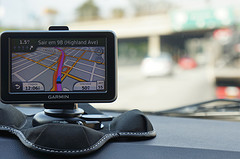This is an age of information and technology that has led to nearly everything around us being smarter. (Except perhaps the people.)
Electronic and digital components have entered our homes, offices, and automobiles, and made them all seem like smarter locations.
In the huge world of “smart” technology, the automotive electronics market is perhaps the top of the heap. Indispensable features such as electronic stability control and anti-lock braking systems and are great choices for smart and safe automotive electronics. Why not consider buying a used car or used truck with these features?

flic.kr/p/chBCpY
There has been a huge increase in the number of electronic devices installed at automotive plants in the recent decade. As an example, the Apollo 11 space craft traveled to the moon and back using a tiny 150 kilobytes of onboard memory. It’s remarkable to think that the typical music player uses a whopping 500 kilobytes just to keep our favorite songs from skipping. Listening to skip-free music is a mere iota of how electronics have impacted a car’s performance in order to benefit driving consumers.
Telematics is the most popular term used for the technology that involves automobile communication systems. Telematics was originally used to describe the blending of telecommunications and informatics or information technology. This growing industry gets more attention from car manufacturers each year. In the mid-1990s, industry insiders predicted that telematics would become “the” go-to technology, and foresaw increasing overall sales and more importantly, transforming the automotive industry into a major player in mobile technology. In reality, these forecasts were too optimistic. From an initial industry projection of over $40 billion dollars, the figure became less than half that, as more conservative measures were adopted.
However, telematics technology will not be abandoned. In fact, on average automobile manufacturers spend $2000 on electronic systems for every vehicle that comes off the line — a huge increase from the $110-per-car budget of the early 1970s. This increase in spending is reflected in everything from engine performance to safety devices, entertainment systems, and security features. Every component of the vehicle works together to create automobiles that perform better, are more comfortable, and ultimately safer to drive.
Some of the most widely adopted smart and safe automotive electronics are as follows:
Fuel Efficiency
Skyrocketing fuel prices have forced automotive manufacturers to realize the need for fuel-efficient vehicles, and to meet that demand. Smart automotive electronics are used to create the more efficient burning of fuel, such as the electronic fuel injection system (EFI). The technology used in hybrid vehicles takes this one step further, with electronic devices that allow the driver to automatically switch between gas and electric engines.
Controller Area Network
More than one computer runs your car. There is actually a network of computers called the Controller Area Network (CAN). Like a LAN (Local Area Network) that’s commonly used in home and business computers, the CAN links computers together. In your vehicle, the CAN basically links the many separate computer systems together and allows them communicate with each other. These interconnected systems involve everything from critical systems like engine management, cruise control and anti-lock brakes, to less-demanding applications like automatic window and seat controls.
Safety Devices
There are generally two categories of devices designed to protect the safety of the driver and passengers: active and passive safety devices.
* Passive safety devices: While these features may be more visible and seem simpler, they are also controlled by smart and safe automotive electronics. Thanks to developments in electronics and technology, airbag deployment has seen a tremendous amount of improvement over the years. Early airbags would deploy too early or too late, offering little or no benefit to the driver and passengers. Now, more advanced systems have created devices in your car that are actually programmed to the conditions that can lead to a high collision impact. Airbag and seating adjustment systems are deployed to minimize impact and decrease the degree of injury to the people inside the vehicle.
* Active safety devices: These are systems that constantly work to ensure the safety of drivers and passengers. Examples of active safety devices are dynamic steering response (DSR), traction control (TCS), and acceleration slip regulation (ASR). While the average driver may not notice these systems at work, they are constantly sensing road and driving conditions and adjusting the car’s performance accordingly to create a safer ride. Electronic Stability Control has been shown by researchers to have a large safety benefit in reducing single vehicle skids.
Think of the advancements over just a decade, and you’ll agree that the car of today certainly is a far cry from its predecessors. Modern cars and trucks offer more than merely a means of getting from point A to point B. Smart and safe automotive electronics make “getting there” as secure and comfortable as possible.
Tagged with: electronic stability control • smart technology
Filed under: New Technology